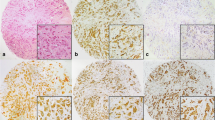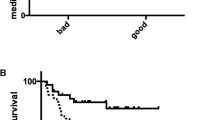Abstract
The goal of this study was to determine the diagnostic and prognostic potential of X-linked inhibitor of apoptosis (XIAP) expression in breast cancer. We analyzed a tissue microarray comprised of 100 breast cancer cases and 70 matched normal samples. Analysis of an online database, which included 2,977 patients, was also performed. There was a significant difference in cytoplasmic expression of XIAP (XIAP-C) between breast cancer tissue and matched normal (p < 0.001). Staining of XIAP-C was defined as negative (breast cancer 8.42 % vs. normal 30.91 %), slight (40.0 vs. 45.45 %), moderate (43.16 vs. 23.64 %), or high (8.42 vs. 0 %). High XIAP-C protein expression correlated with human epidermal growth factor receptor 2 (HER-2) status (p = 0.010) and with human p53 mutant-type (P53) status (p = 0.039). We found that XIAP expression did not correlate with disease-free survival (p = 0.706) and overall survival (p = 0.496) of breast cancer patients. An Internet-based system analysis confirmed our results. In the subgroup analysis, basal-like breast cancer patients with high XIAP levels in the tumor had a significantly increased risk of relapse; thus, the up-regulation of XIAP appeared to be predictive of poor relapse-free survival (p = 0.013). Kaplan–Meier curves also identified a significant correlation between distant metastasis-free survival and XIAP expression in patients with lymph-node-negative disease (p = 0.030). In summary, expression of XIAP-C was significantly higher in breast cancer compared to normal tissue. XIAP-C expression correlated with HER-2 status and may be considered a prognostic biomarker for basal-like breast cancer patients.




Similar content being viewed by others
References
Yuan Y, Liao Y-M, Hsueh C-T, Mirshahidi HR. Novel targeted therapeutics: inhibitors of MDM2, ALK and PARP. J Hematol Oncol. 2011;4:16.
Firer MA, Gellerman G. Targeted drug delivery for cancer therapy: the other side of antibodies. J Hematol Oncol. 2012;5:70.
Chaoquan H, Huang L, Gest C, Xi X, Janin A, Soria C, Li H, He L. Opposite regulation by PI3 K/Akt and MAPK/ERK pathways of tissue factor expression, cell-associated procoagulant activity and invasiveness in MDA-MB-231 cells. J Hematol Oncol. 2012;5:16.
Chiang H-C, Nair SJ, Yeh I-T, Santillan AA, Hu Y, Elledge R, Li R. Association of radiotherapy with preferential depletion of luminal epithelial cells in a BRCA1 mutation carrier. Exp Hematol Oncol. 2012;1:31.
Vaux DL, Silke J. Mammalian mitochondrial IAP binding proteins. Biochem Biophys Res Commun. 2003;3:499–504.
Schimmer AD, Welsh K, Pinilla C, Wang Z, Krajewska M, Bonneau MJ, Pedersen IM, Kitada S, Scott FL, Bailly-Maitre B, Glinsky G, Scudiero D, Sausville E, Salvesen G, Nefzi A, Ostresh JM, Houghten RA, Reed JC. Small-molecule antagonists of apoptosis suppressor XIAP exhibit broad antitumor activity. Cancer Cell. 2004;1:25–35.
Deveraux QL, Takahashi R, Salvesen GS, Reed JC. X-linked IAP is a direct inhibitor of cell-death proteases. Nature. 1997;6639:300–4.
Deveraux QL, Roy N, Stennicke HR, Van Arsdale T, Zhou Q, Srinivasula SM, Alnemri ES, Salvesen GS, Reed JC. IAPs block apoptotic events induced by caspase-8 and cytochrome c by direct inhibition of distinct caspases. EMBO J. 1998;8:2215–23.
Deveraux QL, Leo E, Stennicke HR, Welsh K, Salvesen GS, Reed JC. Cleavage of human inhibitor of apoptosis protein XIAP results in fragments with distinct specificities for caspases. EMBO J. 1999;18:5242–51.
Mohapatra S, Chu B, Zhao X, Pledger WJ. Accumulation of p53 and reductions in XIAP abundance promote the apoptosis of prostate cancer cells. Cancer Res. 2005;65:7717–23.
Cummins MJ, Kohli M, Rago C, Kinzler KW, Vogelstein B, Bunz F. X-linked inhibitor of apoptosis protein (XIAP) is a nonredundant modulator of tumor necrosis factor-related apoptosis-inducing ligand (TRAIL)-mediated apoptosis in human cancer cells. Cancer Res. 2004;64:3006–8.
Berezovskaya O, Schimmer AD, Glinskii AB, Pinilla C, Hoffman RM, Reed JC, Glinsky GV. Increased expression of apoptosis inhibitor protein XIAP contributes to anoikis resistance of circulating human prostate cancer metastasis precursor cells. Cancer Res. 2005;65:2378–86.
Yang XH, Feng ZE, Yan M, Hanada S, Zuo H, Yang CZ, Han ZG, Guo W, Chen WT, Zhang P. XIAP is a predictor of cisplatin-based chemotherapy response and prognosis for patients with advanced head and neck cancer. PLoS One. 2012;3:e31601.
Chen X, Wang T, Yang D, Wang J, Li X, He Z, Chen F, Che X, Song X. Expression of the IAP protein family acts cooperatively to predict prognosis in human bladder cancer patients. Oncol Lett. 2013;4:1278–84.
Shi YH, Ding WX, Zhou J, He JY, Xu Y, Gambotto AA, Rabinowich H, Fan J, Yin XM. Expression of X-linked inhibitor-of-apoptosis protein in hepatocellular carcinoma promotes metastasis and tumor recurrence. Hepatology. 2008;2:497–507.
Györffy B, Lanczky A, Eklund AC, Denkert C, Budczies J, Li Q, Szallasi Z. An online survival analysis tool to rapidly assess the effect of 22,277 genes on breast cancer prognosis using microarray data of 1,809 patients. Breast Cancer Res Treat. 2010;3:725–31.
Zhang Y, Wang Y, Gao W, Zhang R, Han X, Jia M, Guan W. Transfer of siRNA against XIAP induces apoptosis and reduces tumor cells growth potential in human breast cancer in vitro and in vivo. Breast Cancer Res Treat. 2006;3:267–77.
Hu Y, Cherton-Horvat G, Dragowska V, Baird S, Korneluk RG, Durkin JP, Mayer LD, LaCasse EC. Antisense oligonucleotides targeting XIAP induce apoptosis and enhance chemotherapeutic activity against human lung cancer cells in vitro and in vivo. Clin Cancer Res. 2003;9:2826–36.
Lima RT, Martins LM, Guimarães JE, Sambade C, Vasconcelos MH. Specific downregulation of bcl-2 and xIAP by RNAi enhances the effects of chemotherapeutic agents in MCF-7 human breast cancer cells. Cancer Gene Ther. 2004;11:309–16.
Wang H, Huang M, Zhang DY, Zhang F. Global profiling of signaling networks: study of breast cancer stem cells and potential regulation. Oncologist. 2011;16:966–79.
Zhang FC, Song SL, Ma Y, Tang L, Xu YC, Wang HX. Effect of fibroblasts on breast cancer cell mammosphere formation and the regulation of stem cell-related gene expression. Int J Mol Med. 2011;3:365–71.
Xu YC, Wang HX, Tang L, Ma Y, Zhang FC. A systematic review of vinorelbine for the treatment of breast cancer. Breast J. 2013;2:180–8.
Wang HX, Zhang FC, Ye F, Ma Y, David YZ. The effect of coptis chinensis on the signaling network in the squamous carcinoma cells. Front Biosci. 2011;3:326–40.
Zhang S, Ding F, Luo A, Chen A, Yu Z, Ren S, Liu Z, Zhang L. XIAP is highly expressed in esophageal cancer and its downregulation by RNAi sensitizes esophageal carcinoma cell lines to chemotherapeutics. Cancer Biol Ther. 2007;6:6973–80.
Bilim V, Yuuki K, Itoi T, Muto A, Kato T, Nagaoka A, Motoyama T, Tomita Y. Double inhibition of XIAP and Bcl-2 axis is beneficial for retrieving sensitivity of renal cell cancer to apoptosis. Br J Cancer. 2008;98:941–9.
Shi RX, Ong CN, Shen HM. Protein kinase C inhibition and x-linked inhibitor of apoptosis protein degradation contribute to the sensitization effect of luteolin on tumor necrosis factor-related apoptosis-inducing ligand-induced apoptosis in cancer cells. Cancer Res. 2005;65:7815–23.
Sun H, Lu J, Liu L, Yi H, Qiu S, Yang CY, Deschamps JR, Wang S. Nonpeptidic and potent small-molecule inhibitors of cIAP-1/2 and XIAP proteins. J Med Chem. 2010;17:6361–7.
Amantana A, Lon don CA, Iversen PL, Devi GR. X-linked inhibitor of apoptosis protein inhibition induces apoptosis and enhances chemotherapy sensitivity in human prostate cancer cells. Mol Cancer Ther. 2004;3:699–707.
Ming L, Tao S, Zhen-fei Y, Yan-qun NA. XIAP as a prognostic marker of early recurrence of nonmuscular invasive bladder cancer. Chin Med J. 2007;6:469–73.
Arnt CR, Chiorean MV, Heldebrant MP, Gores GJ, Kaufmann SH. Synthetic Smac/DIABLO peptides enhance the effects of chemotherapeutic agents by binding XIAP and cIAP1 in situ. J Biol Chem. 2002;46:44236–43.
Mizutani Y, Nakanishi H, Li YN, Matsubara H, Yamamoto K, Sato N, Shiraishi T, Nakamura T, Mikami K, Okihara K. Overexpression of XIAP expression in renal cell carcinoma predicts a worse prognosis. Int J Oncol. 2007;30:919–25.
Che Y, Ye F, Xu R, Qing H, Wang X, Yin F, Cui M, Burstein D, Jiang B, Zhang DY. Co-expression of XIAP and cyclinD1 complex correlates with a poor prognosis in patients with hepatocellular carcinoma. Am J Pathol. 2012;5:1798–807.
Zhang Y, Zhu J, Tang Y, Li F, Zhou H, Peng B, Zhou C, Fu R. X-linked inhibitor of apoptosis positive nuclear labeling: a new independent prognostic biomarker of breast invasive ductal carcinoma. Diagn Pathol. 2011;6:49.
Yang L, Cao Z, Yan H, Wood WC. Coexistence of high levels of apoptotic signaling and inhibitor of apoptosis proteins in human tumor cells: implication for cancer specific therapy. Cancer Res. 2003;20:6815–24.
Jaffer S, Orta L, Sunkara S, Sabo E, Burstein DE. Immunohistochemical detection of antiapoptotic protein X-linked inhibitor of apoptosis in mammary carcinoma. Hum Pathol. 2007;6:864–70.
Vitté-Mony I, Korneluk RG, Diaz-Mitoma F. Role of XIAP protein, a human member of the inhibitor of apoptosis (IAP) protein family, in phytohemagglutinin-induced apoptosis of human T cell lines. Apoptosis. 1997;2:501–9.
Tenev T, Zachariou A, Wilson R, Ditzel M, Meier P. IAPs are functionally non-equivalent and regulate effector caspases through distinct mechanisms. Nat Cell Biol. 2005;1:70–7.
Xiang G, Wen X, Wang H, Chen K, Liu H. Expression of X-linked inhibitor of apoptosis protein in human colorectal cancer and its correlation with prognosis. J Surg Oncol. 2009;8:708–12.
Kim MA, Lee HE, Lee HS, Yang HK, Kim WH. Expression of apoptosis-related proteins and its clinical implication in surgically resected gastric carcinoma. Virchows Arch. 2011;5:503–10.
Aird KM, Ding X, Baras A, Wei J, Morse MA, Clay T, Lyerly HK, Devi GR. Trastuzumab signaling in ErbB2-overexpressing inflammatory breast cancer correlates with X-linked inhibitor of apoptosis protein expression. Mol Cancer Ther. 2008;1:38–47.
Acknowledgments
We thank Dr Stephen Clarke and Scientist Lucy in the Kolling Institute of RNS Hospital of Austria for technical assistance and paper revision. Written consent for publication is obtained from the patients or their relatives. This study was supported by the National Natural Science Funds (Project Number: 81102015 and 81301858), the National Program on Key Basic Research Project (973 Program) (Project Number: 2013CB967201), the Special Funds for Technological Innovation of Shanghai Jiaotong University (Project Number: YG2012MS46) and Shanghai Municipal Commission of Health and Family Planning.
Conflict of interests
This paper has never been published and is not under simultaneous review by another journal. All authors have read and approved to submit it to your journal. There is no conflict of interest of any authors in relation to the submission.
Author information
Authors and Affiliations
Corresponding authors
Rights and permissions
About this article
Cite this article
Xu, YC., Liu, Q., Dai, JQ. et al. Tissue microarray analysis of X-linked inhibitor of apoptosis (XIAP) expression in breast cancer patients. Med Oncol 31, 764 (2014). https://doi.org/10.1007/s12032-013-0764-8
Received:
Accepted:
Published:
DOI: https://doi.org/10.1007/s12032-013-0764-8




